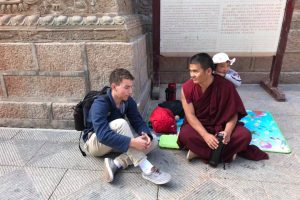Postcards From China Blog #8: Learning Without a Textbook
October 26, 2018
 by Jonathan Frink (visiting student from Gordon College)
by Jonathan Frink (visiting student from Gordon College)
Did you know — students from other colleges and universities are invited to apply for Asbury University’s study abroad programs? Learn more.
The past two months have been full of learning, both inside and outside of the classroom. One unique thing about Asbury University’s China Study Abroad program that I have enjoyed has been how our classroom learning is supplemented with excursions to observe and educate ourselves “without a textbook.” The topics we study in the traditional classroom become a lot more real when you actually see history, culture and current events happen in person.
One course that we are taking this semester is called Area Study of China. This course gives a general overview of the politics, history and economics of China. In the first couple weeks of the class, we talked about the geographical makeup of China and the many different minority groups that live throughout the country. For example, in Western China, specifically in the autonomous regions of Tibet and Xinjiang, there is a high population of minority groups which include Hui or Ugyhur Muslims and Tibetan Buddhists. The beliefs of these minority groups were brought to China by the Silk Road. Not only was this road a flow of goods, it was also a path for foreign ideas. These foreign ideas are still seen in China to this very day.
This past week, we took an “excursion” to Xining which is close to Tibet and Xinjiang and got to experience, in person, what we have been studying in class. We drove out to Kumbum Monastery, which is one of the largest monasteries in China. They specifically practice Tibetan Buddhism. It was truly one of the most eye-opening experiences to see such a radically different faith from my own. The temples were full of elaborate metal idols with jewelry and intricate paintings surrounding them on the wall.
As we walked around, the temples were filled with monks and visitors searching earnestly for peace and truth. As a believer, with a sure hope in Christ, my heart ached to see these fellow image bearers longing for a hope that was not eternal. As these people left the monastery, they were left with the idea that they must continue to do more, pray harder and help more people. This was in stark contrast to our worldview, in which we are saved by grace, not works.
There were two main lessons that I took away from the topics covered in class and through our field trips.
- In modern-day China, Buddhism from India and others faiths like Islam, still have a huge influence on the minds and hearts of Chinese people today.
- I learned the importance of understanding the cultures and traditions that are influencing the people in the country you are living in. For me, specifically in Western China, it was understanding where Tibetan Buddhism came from, learning about the specific beliefs of Tibetan Buddhism and getting to observe people practicing their faith.
As I put into practice the lessons I learned, I am reminded to continually trust ‘the One’ who understands and loves the hearts and minds of every people group in the world. I’m glad to have the opportunity to learn these lessons about faith and culture on Asbury’s China Study Abroad program. I’m also excited to see what other lessons my classmates and I learn during our last few weeks studying abroad in China.